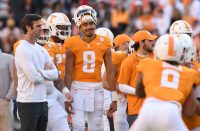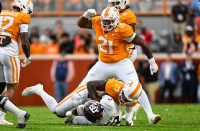In late September 2015, after two of the most difficult losses of the modern era, we researched how often the Vols had historically blown leads. In 17 years Phillip Fulmer’s teams blew a two-possession lead in a loss just six times:
- 1994 at Mississippi State: led 21-7 third quarter, lost 24-21
- 1995 at Florida: led 30-14 second quarter, lost 62-37
- 1999 at Arkansas: led 24-14 third quarter, lost 28-24
- 2001 vs Georgia: led 14-3 first quarter, lost 26-24
- 2001 SEC Championship vs LSU: led 17-7 second quarter, lost 31-20
- 2006 vs Florida: led 17-7 third quarter, lost 21-20
In just his first four years, Butch Jones’ teams have also blown a two-possession lead in a loss six times:
- 2014 at Georgia: led 10-0 first quarter, lost 35-32
- 2014 vs Florida: led 9-0 fourth quarter, lost 10-9
- 2015 vs Oklahoma: led 17-0 second quarter, lost 31-24 (2OT)
- 2015 at Florida: led 27-14 fourth quarter, lost 28-27
- 2015 vs Arkansas: led 14-0 first quarter, lost 24-20
- 2016 at Vanderbilt: led 34-24 third quarter, lost 45-34
Fulmer’s Vols never blew a two-possession lead in the fourth quarter. Jones’ Vols did it three times in a span of 13 games against Florida in 2014 and 2015 and Oklahoma in 2015. Before then you have to go back to 1986 to find a Tennessee squad that lost a game in which it led by two possessions in the fourth quarter.
But, consider this: by my count Fulmer’s Vols came from two possessions behind to win 10 times in 17 years:
- 21 points: Kentucky 2001, LSU 2005
- 18 points: Arkansas 1998
- 17 points: Georgia 2006
- 15 points: Kentucky 1995, Vanderbilt 2007
- 13 points: Alabama 1996, Auburn 1997
- 10 points: Arkansas 1995
- 9 points: Kentucky 2004
Meanwhile, Butch’s Vols have come back from two possessions behind to win six times in just the last three years:
- 21 points: Georgia 2015, Florida 2016
- 17 points: Georgia 2016
- 14 points: South Carolina 2014, Virginia Tech 2016
- 10 points: Appalachian State 2016
Quality of opponent is also interesting here: 40% of Fulmer’s comeback list is Kentucky or Vanderbilt, while two-thirds of Butch’s came against teams who were ranked at the time or finished the year that way.
Say what you will about Butch Jones (or Josh Dobbs, the quarterback of every one of those comebacks). The bigger point? Pace of play has significantly changed how we watch college football.
Getting down 14 points used to create panic; Fulmer’s Vols only came back from such a deficit six times in 17 years. But today, it’s not a big deal: Butch’s Vols have come back from down 14 points five times in the last 31 games.
Getting up by a similar margin is also no sure thing anymore. Fulmer’s Vols only blew two leads of 12+ points ever, and only one if you remove games started by Todd Helton at quarterback. When Tennessee got up that much, the Vols were a lock (in part because of a far greater talent advantage). But the 2015 Vols blew 12+ point leads against three consecutive FBS foes.
Pace of play has increased the number of total plays per game, which means the opportunity to blow a lead or come back from a hole is greater now than it was in Fulmer’s day. More plays also means more opportunity for injury, which as we know can create all kinds of havoc in both an individual’s playing career and a season’s narrative.
Check out the total number of snaps Tennessee’s defense has faced in the last nine years:
| Season | Opponent Plays | Per Game |
| 2008 | 776 | 64.7 |
| 2009 | 852 | 65.5 |
| 2010 | 913 | 70.2 |
| 2011 | 752 | 62.7 |
| 2012 | 923 | 76.9 |
| 2013 | 827 | 68.9 |
| 2014 | 892 | 68.6 |
| 2015 | 904 | 69.5 |
| 2016 | 1000 | 76.9 |
Last year the Vols were one of only nine defenses to face 1,000 plays while playing only 13 games. The 2016 defense clearly had problems that went beyond injuries, depth, and fatigue. But no one should pretend this kind of workload wasn’t a significant factor.
Numbers like these are also why using yards/points per game is so misleading. Missouri gained 740 yards on the Vols, but did so in 110 plays. In yards per play it was only the fourth worst performance of the season for the Tennessee defense. Team 120’s season total in yards per play allowed (5.84) was better than not just Sal Sunseri’s 2012 debacle (6.13), but also Butch’s first year in 2013 (6.07).
These numbers suggest Tennessee is going to blow some leads this fall. They also suggest no one should panic if Tennessee falls behind by two scores. I’m sure there are things for Butch to consider in how he prepares his team and keeps them locked in during games. But overall I think this has less to do with Butch Jones and more to do with the current reality of the game. And for coaches, players, and fans alike, it means a higher percentage of meaningful snaps.
[ess_grid alias=”grt-2017-promo-grid”][/ess_grid]




